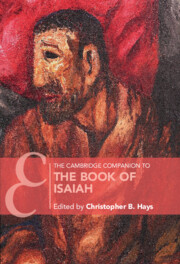Book contents
- The Cambridge Companion to the Book of Isaiah
- Frontispiece
- Cambridge Companions to Religion
- The Cambridge Companion to the Book of Isaiah
- Copyright page
- Contents
- Notes on Contributors
- Acknowledgments
- Timeline of Events Related to the Book of Isaiah
- Abbreviations
- Maps
- 1 Introduction
- Part I The Book of Isaiah Through History
- Part II Isaiah in Its Cultural World
- Part III Isaiah as Literature
- 12 Isaiah as Poetry
- 13 Isaiah in Intertextual Perspective
- 14 Gendered Imagery in Isaiah
- 15 Divine and Human Plans in the Book of Isaiah
- Part IV Afterlives of the Book of Isaiah
- Scripture Index
- Other Texts Index
- Subject Index
- Cambridge Companions to Religion ()
- References
13 - Isaiah in Intertextual Perspective
from Part III - Isaiah as Literature
Published online by Cambridge University Press: 08 November 2024
- The Cambridge Companion to the Book of Isaiah
- Frontispiece
- Cambridge Companions to Religion
- The Cambridge Companion to the Book of Isaiah
- Copyright page
- Contents
- Notes on Contributors
- Acknowledgments
- Timeline of Events Related to the Book of Isaiah
- Abbreviations
- Maps
- 1 Introduction
- Part I The Book of Isaiah Through History
- Part II Isaiah in Its Cultural World
- Part III Isaiah as Literature
- 12 Isaiah as Poetry
- 13 Isaiah in Intertextual Perspective
- 14 Gendered Imagery in Isaiah
- 15 Divine and Human Plans in the Book of Isaiah
- Part IV Afterlives of the Book of Isaiah
- Scripture Index
- Other Texts Index
- Subject Index
- Cambridge Companions to Religion ()
- References
Summary
One of the poetic features of Isaiah is its intertextuality. The authors of the later portions of the book worked with attention to the existing Isaianic texts, so that the book as a whole is woven together by common themes and vocabulary. Furthermore, the book is full of allusions to other biblical books, and was itself eventually a touchstone for later biblical authors. (Sometimes it is even uncertain which text came first!) Hyun Chul Paul Kim, in “Isaiah in Intertextual Perspective,” analyzes the book at each of these levels, and then looks forward to “points of intersectionality” between Isaiah and the modern world.
Keywords
- Type
- Chapter
- Information
- The Cambridge Companion to the Book of Isaiah , pp. 205 - 224Publisher: Cambridge University PressPrint publication year: 2024

